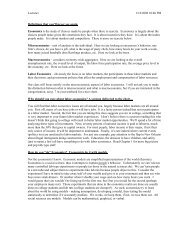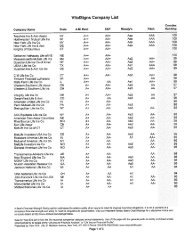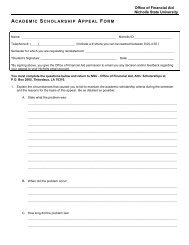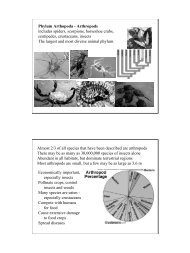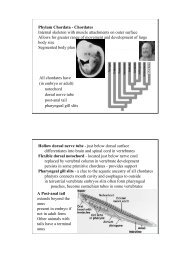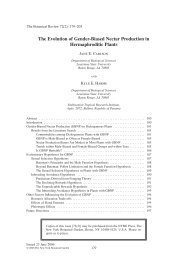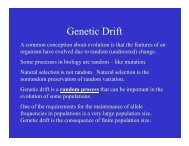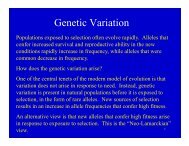Homework, Chapter 2 1) A proton moves 2.00 cm parallel and in the ...
Homework, Chapter 2 1) A proton moves 2.00 cm parallel and in the ...
Homework, Chapter 2 1) A proton moves 2.00 cm parallel and in the ...
Create successful ePaper yourself
Turn your PDF publications into a flip-book with our unique Google optimized e-Paper software.
<strong>Homework</strong>, <strong>Chapter</strong> 21) A <strong>proton</strong> <strong>moves</strong> <strong>2.00</strong> <strong>cm</strong> <strong>parallel</strong> <strong>and</strong> <strong>in</strong> <strong>the</strong> direction of auniform electric field of E=200 N/C. (a) How much work is doneby <strong>the</strong> field on <strong>the</strong> <strong>proton</strong>? (b) What change occurs <strong>in</strong> <strong>the</strong> potentialenergy of <strong>the</strong> <strong>proton</strong>? (c) What potential difference did <strong>the</strong> <strong>proton</strong>move through?General Physics II<strong>Chapter</strong> 2, Potential Page 95
2) A charged particle accelerated through a potential difference of60.0 V has its potential energy decreased by 2.4210 -17 J.Calculate <strong>the</strong> charge on <strong>the</strong> particle. Is <strong>the</strong> charge positive ornegative?General Physics II<strong>Chapter</strong> 2, Potential Page 96
4) a) F<strong>in</strong>d <strong>the</strong> electric potential, tak<strong>in</strong>g zero at <strong>in</strong>f<strong>in</strong>ity, at <strong>the</strong> upperright corner (<strong>the</strong> corner without a charge) of <strong>the</strong> rectangle <strong>in</strong> thisfigure. (b) Repeat if <strong>the</strong> <strong>2.00</strong>-μC charge is replaced with a chargeof -<strong>2.00</strong> μC.General Physics II<strong>Chapter</strong> 2, Potential Page 98
5) Three charges are situated at corners of a rectangle as <strong>in</strong> thisfigure. How much energy is required to assemble <strong>the</strong>se charges,assum<strong>in</strong>g <strong>the</strong>y come from a very far distance away?General Physics II<strong>Chapter</strong> 2, Potential Page 99
6) The electric potential <strong>in</strong> a region of space is given by V = 2xy -3zx + 5y 2 , with V <strong>in</strong> volts <strong>and</strong> <strong>the</strong> coord<strong>in</strong>ates <strong>in</strong> meters. If po<strong>in</strong>t Pis at x = 1 m, y = 1 m, z = 1 m, f<strong>in</strong>d (a) <strong>the</strong> potential at P <strong>and</strong> (b)<strong>the</strong> x, y, <strong>and</strong> z components of <strong>the</strong> electric field at P.General Physics II<strong>Chapter</strong> 2, Potential Page 100
8) A series circuit consists of a 0.050-μF capacitor, a 0.100-μFcapacitor, <strong>and</strong> a 400-V battery. F<strong>in</strong>d <strong>the</strong> charge (a) on each of <strong>the</strong>capacitors <strong>and</strong> (b) on each of <strong>the</strong> capacitors if <strong>the</strong>y are reconnected<strong>in</strong> <strong>parallel</strong> across <strong>the</strong> battery.General Physics II<strong>Chapter</strong> 2, Potential Page 102
9) In this figure a 10 V battery is connected across capacitors of capacitances C 1 =2μF,C 2 =4μF, C 3 =2μF, C 4 =12μF, C 5 =8μF, <strong>and</strong> C 6 =8μF. What is <strong>the</strong> equivalent capacitance<strong>and</strong> <strong>the</strong> voltage <strong>and</strong> charge for each capacitor?General Physics II<strong>Chapter</strong> 2, Potential Page 103
10) (a) F<strong>in</strong>d <strong>the</strong> equivalent capacitance of <strong>the</strong> capacitors <strong>in</strong> thisfigure. (b) F<strong>in</strong>d <strong>the</strong> charge on each capacitor <strong>and</strong> <strong>the</strong> potentialdifference across it.General Physics II<strong>Chapter</strong> 2, Potential Page 104
11) Express <strong>the</strong> potential due to this charged bar at P <strong>in</strong> terms of L,d, <strong>and</strong> .General Physics II<strong>Chapter</strong> 2, Potential Page 105
General Physics II<strong>Chapter</strong> 2, Potential Page 106




